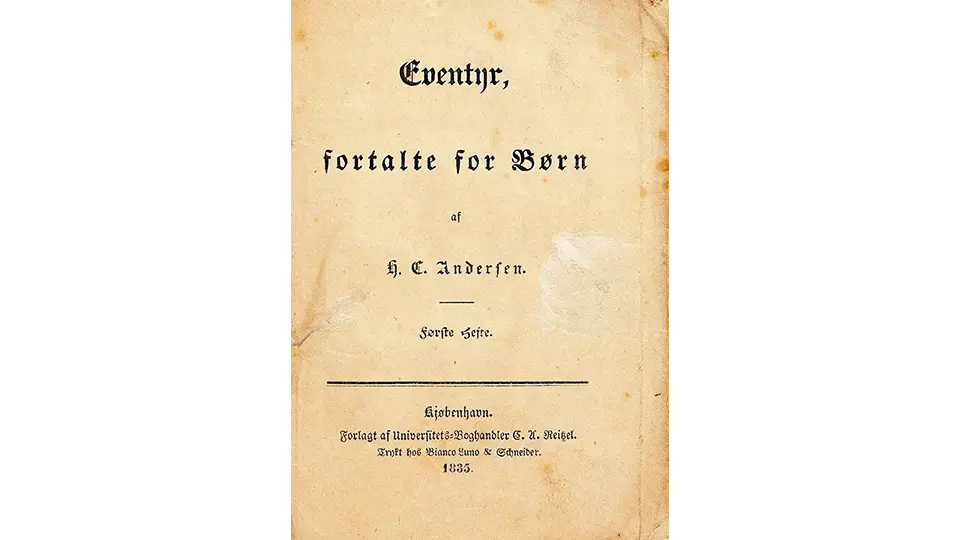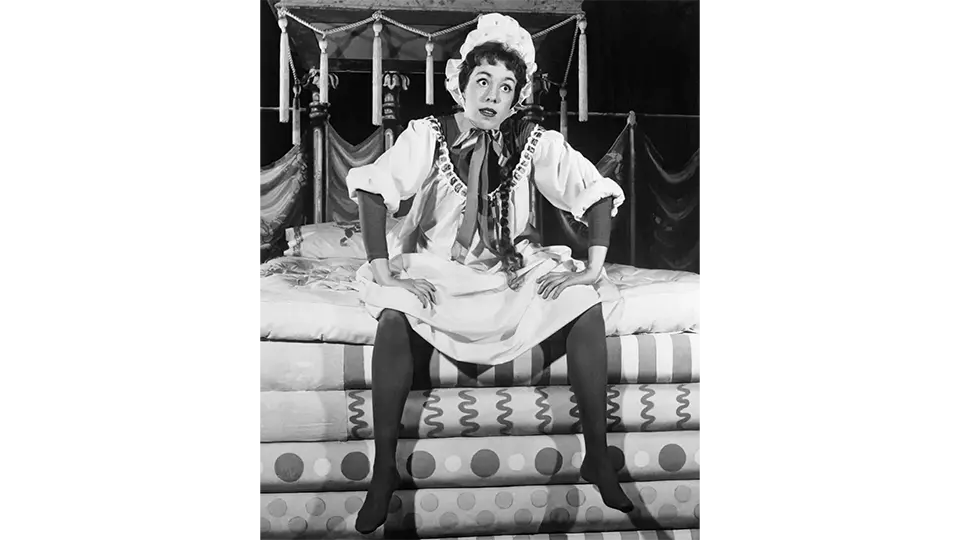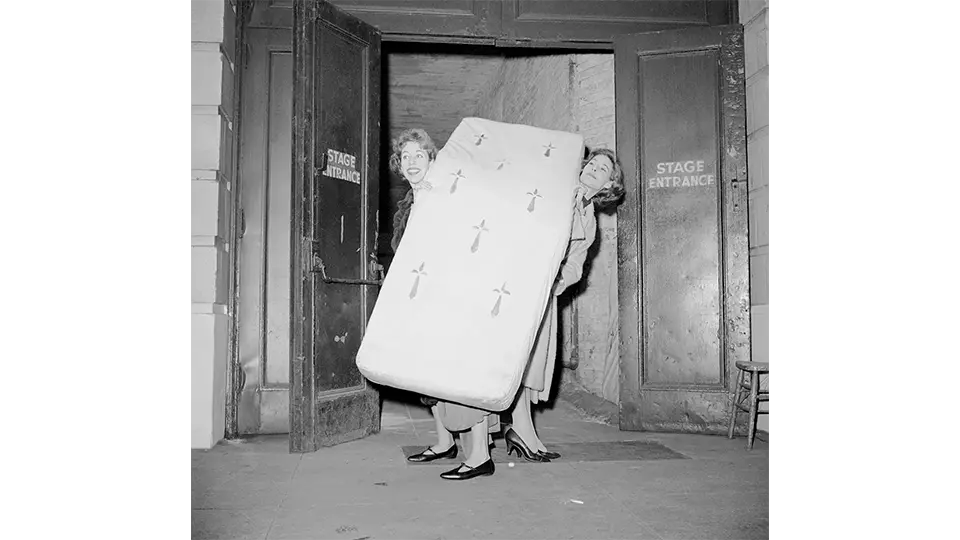Once Upon a Mattress
Once Upon an Adaptation: How Stories Change Over Time
By Emily White
“There are many versions of this story; I sing them all. This is the prettiest, but it’s not quite accurate.” — Jester in Once Upon a Mattress
Once upon a time, a writer named Hans Christian Andersen published a story called “The Princess and the Pea” in Denmark in 1835. It was part of an anthology of several short stories called Tales, Told for Children, First Edition. Unlike many fairytales in which the moral of the story is quite clear, the message in “The Princess and the Pea” is not as obvious, which is perhaps why it is a story that has lent itself so easily to adaptations, including Once Upon a Mattress.

Eventyr, fortalte for Børn — Danish title page of the book where “The Princess and the Pea” was first published; translates in English to Fairy Tales Told for Children
“The Princess and the Pea” tells the story of a prince in search of a wife, who meets a woman who claims to be a princess. In order to test her claims of nobility, the girl must sleep atop 20 mattresses, underneath which—unbeknownst to her—is a single pea. When the young woman wakes in the morning complaining of discomfort sleeping, it proves she must be royal, as only someone of noble birth would be so sensitive. She and the prince wed and the pea is placed in a museum.
Many fairytales such as this one are passed down through the ages in order to convey important moral messages. Andersen’s “The Princess and the Pea,” is barely a page long, and doesn’t name any of its characters. While we can’t know for sure what message Andersen most wanted to say when he published this fairytale, the story of his life and how he rose to fame can give us some clues to his perspective.
Hans Christian Andersen was born into a poor family in Denmark in 1805. In 1811, he auditioned to be an actor at the Royal Theatre in Copenhagen. Although he was not cast in any roles, director and upper-class gentleman Jonas Collin saw potential in Andersen, and he provided money for the boy to attend a prestigious school, and eventually university. Andersen studied writing and then went on to become one of Denmark’s most famous published authors. Perhaps Andersen was grateful for the kindness of the gift of education given to him by the upper class and wanted to emphasize the importance of empathy among the ruling class. Perhaps he was skeptical about the class differences that prevented him from upward mobility without having an upper-class patron.

Hans Christian Andersen
Some scholars believe that the moral behind “The Princess and the Pea” is that in order to be truly noble, one must have the ability to empathize with their subjects, and thus care for them better. In this interpretation, the princess’s physical “Sensitivity” (as Queen Aggravain would put it) is indicative of her emotional sensitivity. Some scholars interpret this story as a mockery of the upper class—the tiny pea representing the idea that nobles can become disturbed by the slightest difficulties, because they are not in touch with everyday struggles. This interpretation might make more sense in a time and place where kings and queens no longer have relevance. The meaning of the story can change based on who is telling it and where and when it is being told.
In fact, “The Princess and the Pea” is not the only tale that involves nobility and their trouble sleeping on small objects. Andersen claimed it was a story passed down to him from his childhood, so it may have had a different meaning before he wrote it down. Stories with similar motifs but different moral messages appear throughout history and in different countries. A story from Sweden published around the same time as Andersen’s “The Princess and the Pea” called “The Palace that Stood on Golden Pillars” involves a peasant girl who becomes a princess with the help of a talking cat. Part of her journey to becoming a princess involves a skeptical queen placing a single bean underneath the girl’s mattress to test her nobility. A story from India in the 1100s involves a competition between three upper-class brothers, each of which wants to prove he is the most fastidious. The brother who wins the competition is disturbed by a single hair underneath his mattress during sleep. It’s possible all these stories come from the same original source, but each storyteller was adapting it over time to meet the needs of their audience.
When Mary Rodgers first started adapting her version of “The Princess and the Pea,” she was a 27-year-old mother of three in 1958 New York. As the daughter of the famous composer Richard Rodgers, she felt she had a lot to live up to as a composer. This was especially true at the musical theater intensive she was attending that year, where she strove to prove her worth among a group of overconfident men, live up to her family name, and find her own voice. Rodgers had her work cut out for her before she even started writing music.
Lyricist and book writer Marshall Barer paired with Rodgers on an adaptation of “The Princess and the Pea.” They were tasked with creating a piece that included substantial roles for the nine principal actors of the company—not an easy task when crafting a standard musical in only a few weeks. The actors each demonstrated a range of different talents—some were comedic stars but not singers, some sang beautifully but weren’t dancers, etc. In order to fulfill all these needs, Rodgers and Barer, along with support from Jay Thompson and Dean Fuller, created the show by crafting characters to fit the talents of the individual actors. The King, for example, was created for an actor who was well-known for his comedic skills, but according to Rodgers, “couldn’t sing on key and couldn’t memorize lines.” Why not create a character who only speaks in pantomime? By the end of that summer of 1958, The Princess and the Pea musical was first staged. In 1959, it went to Broadway under a new name, Once Upon a Mattress, and starred a young Carol Burnett in her first Broadway role.

Carol Burnett as Princess Winnifred the Woebegone in Once Upon a Mattress in 1959
Mattress quickly became a hit. Mary Rodgers was lauded by The New York Times as “a genuine new composer,” and Burnett as “a funny new clown.” Burnett became a household name, and Rodgers went on to become a successful writer, most notably for the novel Freaky Friday in 1972. Mattress was beloved by audiences for its humor and brilliant score, and it is notable for presenting in Winnifred an alternative model to stereotypical femininity that was prominent in the late 1950s, ahead of the second wave feminist movement. Though the song at the beginning of the show describes a princess as “a delicate thing/delicate and dainty as a dragonfly’s wing,” Princess Winnifred the Woebegone is anything but. Winnifred is strong and independent, lifting weights and speaking her mind throughout the show. She is an underdog and outsider to this castle and court. We see by the way she treats others with respect and embodies a positive outlook that she quickly wins over the hearts of the people who would be her subjects if she marries Prince Dauntless. And thus she seems fit to rule over her subjects. The means of demonstrating emotional “Sensitivity” are different in Rodgers’s princess than Andersen’s princess, but at its core the theme remains that a leader should care about those they lead.

Carol Burnett (L) and Mary Rodgers (R) carry a mattress prop for the show into a Broadway theater
What does the story of a princess and her restless sleep mean today? In Hans Christian Andersen’s time, it may have been a lesson to nobility of the importance of emotional sensitivity. In Mary Rodgers’s time, it was a portrait of a strong young woman who stood up for herself, and perhaps embodied the values of a young woman who wanted to be recognized on the merit of her own skill. When Once Upon a Mattress presents the story of “The Princess and the Pea” in 2023, it inherently reflects back the context of the world in which it is presented. What does the show mean to you today? How would you adapt this fairytale to tell your story?